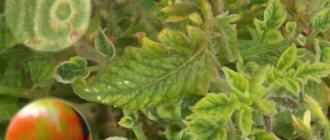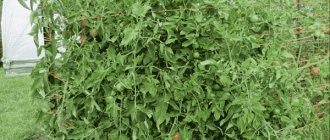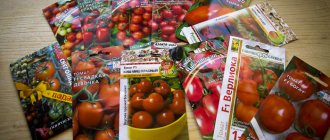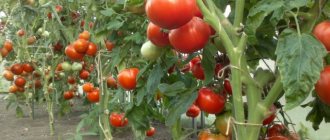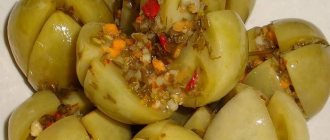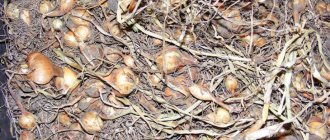July begins.
The powerful tomato bushes, which have gained strength, are bearing fruit. But it's worth taking a closer look at the bright, green foliage. Perhaps there is already a villain lurking there who can destroy this splendor in a couple of weeks.
This article describes measures to prevent cladosporiosis on tomatoes.
Photo
In the following photo you can see what the disease looks like on tomatoes:
Reasons for the spread of the disease
The main causes of cladosporiosis include the creation of conditions for the development of fungal conidia: high humidity and temperature. Greenhouses fall under these criteria.
Already at air humidity of 80%, the infectious agent is capable of life. At a temperature of +25°C, together with high humidity, optimal conditions are created for the spread of the disease.
This is relevant if tomatoes that were already infected were planted in greenhouses before the new planting, or if the soil was not fully tilled after suffering from cladosporiosis.
Disease spores pose a particular danger. The range of possible sources of infection is wide, and the fungus itself is tenacious. Therefore, to prevent the spread of brown spot, the soil should be carefully cultivated after the previous harvest.
The causative agents of the disease can change. Even if we are talking about resistant tomato varieties, they can become infected with a new strain of the disease.
Reasons for appearance
Fungal spores spread very easily, just a small breeze is enough. The main danger is diseased plants and their undestroyed remains.
The mushroom is insidious. It retains its viability on dry tops and in soil for up to 10 months. Easily tolerates dryness and severe frost.
Transported with dust or successfully surviving the winter, the pathogens spread to healthy tomatoes. It is not necessary that the plant be damaged. The main conditions are high humidity and comfortable temperature. It takes 12-14 days from infection to the appearance of the first signs of cladosporiosis .
Causes of infection
Cladosporiosis most often affects plants grown in unheated greenhouses or greenhouses. The first symptoms appear in the second half of summer, in the southern regions - already in the spring.
The causative agent of the disease
The causative agent of cladosporiosis is the fungus Cladosporium fulvum Cooke. It is distinguished by its durability: it can withstand both cold and heat for 10 months. Infection occurs when the mycelium of the microorganism enters the plant. The pathogen is constantly evolving, adapting to drugs.
The fungus gets on the plants and begins to germinate. The manifestation of its vital activity can be seen in the middle of the growing season. Weakened leaves are the first to be affected.
Important! In addition to leaves, the fungus attacks flowers and young ovaries.
Terms of distribution
The fungus reproduces by conidia (spores), which, due to their lightness, are carried by the wind. The source of infection can also be ordinary objects on which the pathogen came into contact: gardening tools, shoes, water for irrigation.
Peculiarity. The disease is not typical for seedlings grown in open ground.
Fungal spores become active at elevated humidity levels, which is not uncommon in greenhouses. Another factor stimulating the active phase is temperature changes. The optimal indicator for the life of the fungus is +22...+25C with a humidity of 80%. If the humidity drops to 70%, the proliferation of microorganisms stops.
Signs
The disease begins on the lower leaves and rises to the top.
Walking past the plant, you may not notice that the tomato is already affected by brown spot. If you miss the first signs of cladosporiosis, the disease will quickly spread to all tomatoes. It will be extremely difficult to save the plants. The period from infection to death is only 30 days .
In order to detect the disease in time, it is necessary to regularly inspect the leaves of the lower tier.
Light olive-colored spots appear on the upper blade of the affected leaf. Chaotically located and few in number, they stand out little from the general background. This is the initial stage. An advanced disease is characterized by extensive brown spots on the leaves, with a silvery coating on the back of the leaf.
Cladosporiosis is often confused with late blight . With late blight, rounded brown spots scattered around the edges immediately form on the outside of the leaf; after a few days, the fruits are affected. The infection appears anywhere in the bush and begins in August, with the temperature dropping to 10⁰C.
Cladosporiosis of tomatoes: signs of the disease
Cladosporiosis of tomatoes: photo
People are accustomed to calling cladosporiosis brown spot. In general, tomato cladosporiosis is a fungal disease. Plant leaves are susceptible to this disease. In closed spaces, this disease occurs more often than in tomatoes grown in open ground. For example, plants grown in a greenhouse or greenhouse are more susceptible to fungal attack. In order to fight the disease, it is necessary to understand and know what brown spot looks like on a plant.
Cladosporium fulvum Cooke is the fungus that causes this disease in tomatoes. A distinctive feature of the microorganism is its resistance to frost, prolonged drought, and also a fairly long lifespan, up to about 10 months.
When the fungus comes into contact with the plant, its surface is affected. Fungal microorganisms mature directly on the mycelial outgrowths, unlike other spores that develop in the cladosporium. Therefore, the fungus can reproduce asexually. These spores are very light in weight and look like dust particles. Therefore, anything can become the cause of tomato disease. Even when you process or water your tomatoes, fungal spores can land on the surface of the leaves or stems. In addition, pathogens are well transported by air. In addition to all this, the insidiousness of the disease lies in the fact that the fungi themselves can live without the plant. They can overwinter, for example, in the soil, and in the spring they can attack new shoots and seedlings.
Once the fungus has landed on the leaves or stems, it waits for suitable air humidity. When its level reaches approximately 90 or 95 percent, the conidia will awaken and rapidly begin to grow and multiply. Therefore, approximately closer to the middle of the season, when the ovaries and flowers appear on the tomatoes, the first signs of the disease appear. It is at the moment when the plant is actively forming ovaries that you can notice small yellowish spots on the upper side of the leaves. Such spots have different shapes and sizes. However, they are immediately visible in comparison with the rest of the green mass. If you tear off a leaf and look at its back, you will see a white coating. These are conidia. If measures are not taken at this stage, then the spots will darken and take on a brown color. In addition, the texture of the stain will also change. It will become hard and spread throughout the entire leaf. This is how fungi germinate. Over time, the leaves turn yellow, wither and fall off. By the way, it is worth noting that most often this fungus colonizes weak plants with low immunity.
When the plant begins to lose leaves, photosynthesis processes will also be disrupted, since they occur in the leaves. This violation will damage the formation of tomato fruits.
In addition to leaves, fungi often settle on flowers and even on the ovaries of plants. The disease is gradual in nature, so plants can be saved if the first signs of the disease are noticed in time. If the conidia grow strongly, the bush will most likely die. Here experts distinguish several stages of the disease.
It is necessary to carefully examine the bushes when tomatoes begin to bloom. It is necessary to inspect the leaves. If fungus is present, then such a leaf will have light green spots. On the reverse side of the sheet, the spots will be gray in color. At the next stage of the disease, the fungus spreads to the top of the bush and in this case, almost all the leaves of the diseased bush become covered with spots. The stems, as well as the fruits, at this stage of the disease remain intact.
After the stage of yellow spots appearing, there will be brown spots on the leaves. They are especially clearly expressed on the reverse side of the sheet. This indicates that the conidia have sprouted. Then, as the process of photosynthesis is disrupted, the plants gradually die, the leaves begin to slowly dry out and eventually fall off. If the disease has already reached this stage, then the means to combat the disease will not bring the desired effect. The stains spread to the fruits, and they become unfit for consumption.
Thus, if the earliest stage of tomato cladosporiosis begins during the flowering of the bush, then the peak of its activity occurs precisely when the fruits begin to form. If you see brown and dark brown spots on the fruits of a plant, this indicates that the plant will most likely die soon. Moreover, if even one tomato bush is infected, you may soon see symptoms of the disease both on neighboring bushes and throughout the rest of the ridge.
Suitable environmental conditions facilitate increased growth and spread of fungal disease, especially if the greenhouse is warm and humid. You should take this into account during rainy summers and watch your tomatoes very closely. In addition, the fungus actively spreads during sudden temperature changes. So the best thermal regime for the existence of conidia is a temperature of 20-25 degrees, as well as an air humidity level of approximately 80%. If the air is dry, the humidity level is below 70%, then the fungus will not multiply as much.
In order to recognize the signs of cladosporiosis in tomatoes, you just need to carefully examine them. If during the examination you see the presence of light or light green shapeless spots, you need to take action immediately and not wait for the disease to spread. This disease can and should be fought if you want to preserve the tomato harvest this year, as well as next year.
How does olive spot develop?
A small spot forms at the point of parasite penetration. The more resilient the plant, the smaller its size. At the site of the outbreak, a dense velvety formation forms on the reverse side of the leaf.
As it spreads, cladosporiosis covers an increasingly larger area of leaves. Yellow-green spots merge, turn yellow and turn brown. Affected leaves dry out and die. The disease moves up to the next tier. Mass infection leads to damage to flowers and ovaries. The taste of the fruit deteriorates.
At the slightest breath of wind, the spores are transferred to healthy plants. Not only tomatoes, but also other representatives of nightshades can become infected: eggplants, potatoes, peppers.
How does the disease manifest itself?
The first symptoms of cladosporiosis are difficult to notice, so you need to carefully inspect the plants when watering and weeding the beds:
- The spread of the disease begins from the lower shoots.
- The upper part of the leaf blades becomes uneven in color, chaotic light areas appear.
- At the bottom of the sheets there are pale spots that turn brown with a grayish tint (see photo).
- Over time, the structure of the infected areas becomes denser, the surface looks velvety.
- As brown spot develops, the leaves turn yellow, dry out and fall off.
- The productivity of tomatoes decreases, the fruits remain small and ripen slowly.
Ways to fight
Various methods of controlling cladosporiosis are more effective at the early stage of development of this disease.
Agrotechnical methods
- Reduce humidity if possible. Avoid overwatering and do not use sprinkling.
- It is very important to mulch the soil around the tomato. The disease begins on the lower leaves due to soil moisture under the bush. It is good to use cut grass or hay. Under the mulch, in the form of white mold, useful hay bacillus develops, which inhibits the development of cladosporiosis.
- Provide ventilation for the plant and its lower tier. You need to carefully break off the lower leaves and carefully place them in a bucket or plastic bag. Do not compost leaves; it is better to remove them from the garden or burn them. Next, carry out preventive treatment of tomatoes with copper-containing or biological preparations.
- In place of the tomato bed, grow other crops and green manure over the next two years. Cereals and corn are ideal.
Folk remedies
Ineffective for treatment. Well suited as a preventive measure.
- Add 3-4 ml of iodine to one liter of milk and add water to 10 liters. Spray the lower tier of leaves generously, especially on the back side. After 10 days, repeat the treatment.
- Make a natural preparation against fungus, which is also a microfertilizer. Collect weeds: nettle, quinoa, burdock. Finely chop, fill the bucket a third. Add a glass of wood ash, add water and place in the sun. After 3-4 days, a strong fermented infusion is obtained. Dilute one liter of infusion into 10 liters of water. Process tomatoes at least 3 times in July.
- Mix serum with water 1:10. Spray after 10 days.
Chemicals
If the plant is already severely affected, you cannot do without fungicides . Before use, you must carefully read the instructions. Preparations suitable for killing fungus:
- Bravo;
- Ditan-neotech 75 VDG;
- Abiga-pik;
- Polisher;
- Captan;
- Tsineb;
- Kurzat R;
- Mancozeb;
- Consento.
Acrobat MC is a local-systemic fungicide . Valid for 2 weeks. Complexly affects the fungus. Penetrates tissue and destroys the surface. Prevents the formation of spores.
Dilute 20 g of the drug in 4 liters of water. Prepare the working solution before use and store for no more than 3 days. Carry out the treatment in dry, windless weather. If the leaves of the middle tier are damaged, repeat spraying. Price for 20 g of product is 40 rubles.
When using systemic chemicals, the last treatment is carried out no later than 30 days before the tomato harvest.
The Swiss drug Quadris is highly effective against cladosporiosis. For private farms it is available in ampoules of 6 ml, costing 68 rubles.
Biological drugs
The basis of biological products is made up of living microorganisms that destroy the causative agents of cladosporiosis.
The most common drug is Fitosporin . Available in powder and soft plate form.
Prepare a stock solution: dilute 100 g of product in 200 ml of water.
- for prevention, it is enough to dilute 1 tablespoon of prepared mother liquor in 10 liters of water;
- with initial signs of brown spotting, the dose can be increased to 2 tablespoons per 10 liters.
Handle plants very carefully. Moisten the lower leaves generously from the inside. The drops should be small, in the form of fog. Spray once every 10-14 days. In humid weather, reduce the interval between treatments to a week.
Similar drugs : Trichoderma veride, Gamair, Alirin. Alirin and Gamair combine well and enhance each other's effectiveness.
Timely and regular use of biological preparations allows you to slow down and even stop the spread and development of cladosporiosis without chemicals.
Features of treating the disease in a greenhouse
Outdoors, tomatoes are rarely affected by brown spot. Limited space, high temperature and humidity, and the accumulation of condensation on the ceiling and walls create a favorable environment for the pathogen in greenhouses. To avoid high humidity you need to:
- Keep the soil surface practically dry. Tomatoes should be watered no more than once a week. The need for watering is determined by slight wilting of the leaves.
- The greenhouse must be ventilated regularly.
- Maintain the temperature no higher than 25⁰C.
- Carry out preventive measures.
We invite you to watch a video about treating tomatoes from cladosporiosis in a greenhouse:
How and with what to treat
Treatment of cladosporiosis directly depends on the degree of spread of the disease. If you start fighting the disease immediately after identifying light spots, the chances of success are high. If you ignore the disease, there is a chance of losing the entire harvest.
There are two ways to fight diseases: folk remedies and chemistry. For effective treatment, an integrated approach is used. At the first stage, you can tear off the affected leaves and treat with products; when brown spots appear, the plant is unlikely to be helped by anything; it is removed from the garden along with the roots.
Chemicals
Chemicals effectively combat the causative agent of cladosporiosis; they are used even when plants are severely damaged by the disease. Before use, carefully read the instructions and do not violate the manufacturers' recommendations.
It is best to carry out processing in the evening; it is important that there is no rain or strong wind during this period. You can repeat the procedure after two weeks.
Important! Apply chemicals at least a month before harvest.
Broad-spectrum fungicides are suitable for treating brown spot:
- "HOM";
- "Bravo";
- "Polyram";
- "Abiga Peak";
- "Ditan NeoTek 75";
- copper oxychloride.
Traditional methods
The methods used by people are effective only at the beginning of the disease; it will not be possible to cure plants from brown olive spot at an advanced stage.
The following remedies help neutralize the fungus best:
- whey - pour 1 liter of whey into a bucket of water, the solution is suitable for spraying;
- infusion of garlic and iodine - for 1 bucket of water you will need 30 drops of iodine, 1 clove of garlic or 500 g of arrows;
- iodine chloride - the product is suitable for pre-planting treatment of soil and seedlings. 30 g of potassium chloride and 40 drops of iodine are dissolved in a bucket of water. When disinfecting the soil, the solution should reach a depth of 10 cm;
- milk solution with iodine - you will need 0.5 liters of milk, 5 liters of water and 15 drops of iodine;
- wood ash decoction - boil 300 g of ash in 10 liters of water for 25 minutes, then leave to steep for two days;
- manganese solution;
- 1% solution of Bordeaux mixture;
- colloidal sulfur solution - 3 tbsp. dry matter is mixed with 1 tbsp. copper sulfate and 3 tbsp. polycarbacin. The concentrate is diluted in 10 liters of water and 2 tablespoons are added. liquid soap;
- yeast - for spraying use a solution prepared from a dry or wet product.
Attention! For greater effectiveness, you can add liquid soap to the finished solution. Soapy water protects against pests and promotes plant health.
Agrotechnical techniques
At the first signs of disease, you should check the density of the beds. If during planting in the ground the plants were planted in a heap, it is worth thinning out the area so that air can circulate freely between the bushes. The distance between low-growing tomatoes should be 40-50 cm, the beds should be no closer than 50-70 cm.
Effective protection against nightshade diseases is compliance with the rules of crop rotation. You cannot plant tomatoes in the same area year after year. The causative agent of cladosporiosis can remain in the soil for up to a year and infect new seedlings. It is recommended to plant tomatoes in the same beds only after 3-4 years.
Prevention measures
It is impossible to create unbearable conditions for the fungus while growing tomatoes, so preventive measures are very important to combat cladosporiosis .
The parasite develops well at humidity from 58%, in the temperature range 5⁰C-30⁰C, at PH from 2 to 10, in any light up to 23,000 lux. At the same time, the oldest inhabitant of our planet is constantly mutating and adapting.
- Soil improvement. Adding compost and organic matter. Nutrient-rich, breathable soil produces stronger plants that can resist infection.
- Regular watering schedule, without over-drying or over-watering.
- Crop rotation. Many bacteria and fungi live in the soil for years. To avoid cladosporiosis, you need to grow tomatoes in the same place no more than once every three years. Other nightshades should not be planted on the territory of the former tomato planting.
- Sowing cereals after harvesting, it is better to leave winter varieties until spring.
- Regular treatment of tomatoes with biological products from the seedling stage on racks.
- Soil cultivation.
- Thorough cleaning of areas from old debris and crops. Destruction of the remains of infected plants.
- Disinfection of walls, ceilings and frames of greenhouses with pharmaiod.
- Selection of resistant varieties and hybrids.
- Soil solarization. During the hottest, sunny period of summer, place the infected area under film for 6-8 weeks. Long-term exposure to bright daylight, more than 23,000 lux and UV irradiation is detrimental to the fungus.
Tillage
In the fall, carefully collect all old plant debris and destroy it. Dig up the soil.
The most preferable way to improve soil health is to use preparations that contain beneficial microorganisms. The drugs Baikal EM-1 and Baikal EM-5 are effective . 3 weeks before the autumn frosts, the soil is shed with working solutions. Suitable biological products:
- Fitosporin.
- Alirin.
- Baktofit.
- Trichodermin.
Add a teaspoon of product to a bucket of water. Repeat treatment in spring. Biological products do not work well when the temperature drops below 15⁰C.
In advanced cases, chemicals are effective . You can treat the soil:
- 3% solution of Bordeaux mixture;
- 4% – copper oxychloride;
- 2% Oksikhom solution.
Chemicals destroy not only pathogens, but also beneficial microflora. Therefore, it is worth resorting to their use only in extreme cases.
Disinfection of planting material
- Prepare the solution. Dissolve 1.5 g of dry Fitosporin powder in 100 ml of water. Let stand for an hour and a half to activate natural bacteria.
- Soak tomato seeds in Fitosporin solution for 2 hours.
Are there varieties resistant to the disease?
The resistance of a variety to diseases does not mean 100% protection against them, but it allows you to restrain the development of infection for a long time. Prevention against cladosporiosis is still necessary.
Varieties and hybrids that are resistant to cladosporiosis and at the same time, according to reviews, have good taste:
- Our Masha;
- Vezha;
- Pink Magic;
- Pink Paradise;
- Pink Bush;
- Delicacy;
- Ira (cherry);
- Paradisaic delight.
What to do with the seeds and fruits of diseased tomatoes?
The disease is not transmitted by seeds. But cladosporiosis spores persist for up to 10 months and can get onto the seeds from the surface of the fruit. To avoid infection, such seeds are not recommended. Fruits not directly affected by cladosporiosis do not pose a health hazard .
Cladosporiosis of tomatoes in greenhouses and soil: methods of control and preparations
Cladosporiosis of tomatoes in greenhouses and soil: photo
If prevention methods were not carried out or did not bring the desired result, and the tomato bushes were still exposed to the disease, then decisive action should be taken immediately to combat the disease.
Brown spot negatively affects the size of tomato fruits and their taste. In addition, the bushes themselves may die. Treatment of tomato cladosporiosis here depends on what stage of germination the fungus is at at the moment when you start fighting it. When you manage to notice signs of the disease at the beginning of the lesion process, then most likely the treatment will be successful. If the spots have already taken on a brown color, then most likely all the measures taken will be useless. As mentioned above, the result of treatment here depends on when you started it.
To eliminate cladosporiosis of tomatoes, treatment can be carried out using one of two methods. You can use traditional methods. Some resort to chemicals. It is optimal to use both methods to rid crops of the described disease.
If the disease is in the earliest stages of damage to the plant, then the use of folk remedies will be more effective than their application to an already sufficiently developed disease. If, however, you managed to detect signs of the disease at an early stage, then you can carry out the following treatment methods.
Treatment with iodine chloride. This solution must be used to treat the soil and the tomato bushes themselves. You should also make sure that the solution penetrates deep enough into the ground. To prepare a life-saving remedy, you will need about 30 grams of the active substance, which should be mixed in a bucket of water, then adding four dozen drops of iodine.
Whey will also cope well with the initial signs of the disease. It is first diluted with water and the bushes are treated. A liter of whey will be enough for a bucket of water.
Infused garlic will help a lot. To prepare the tincture, you need to infuse one clove of vegetable in ten liters of water. After the composition is ready, it would be logical to add a little more iodine. The milk solution showed good results in the fight against the disease. Here you need to pour 400 grams of milk into a five-liter container of water and add iodine.
The solutions described above can also be used alternately with a weak solution of manganese or with a decoction of ash. To prepare the drug, 350 grams of ash must be boiled for half an hour. Then the concentrate is further diluted with water.
Experienced gardeners also advise that in order to improve the processing result, it is good to add soap solutions. Through an experiment, data was obtained that strong, strong and healthy bushes grew on the land that was treated with water and soap.
If you notice signs of the disease in the later stages, you cannot do without stronger drugs with the addition of chemicals. The latter can be purchased at hardware stores.
However, caution should be exercised here, since all chemicals can be absorbed into the plant and also affect the fruits, the consumption of which will lead to serious harm to the health of people who will consume these fruits.
Therefore, in order to avoid poisoning, these fruits, which were collected after treatment with drugs, should be removed after at least three weeks have passed. Only after maintaining this period of time, you can not fear for the health of the body.
Various preparations are used to treat plants, which are now sold in a wide variety. These will be fungicides that have a multifunctional complex effect.
It should be noted here that before treating plants, the drug must be prepared, following the rules of the instructions provided with each package. Tomatoes are treated with these preparations at least twice, with an interval of approximately two weeks.
Some, in order to fight cladosporiosis, use a special solution, which is prepared on the basis of colloidal sulfur.
To prepare this solution, you need to mix three tablespoons of powder with one tablespoon of copper sulfate and then add three tablespoons of polycarbocin.
All powders are mixed and diluted in a bucket of water. It is also good to add a couple of spoons of liquid soap before treating the plant.
Thus, tomato cladosporiosis is a fairly serious disease that causes great damage to cultivated crops. The disease not only negatively affects the tomato harvest, but can also lead to the bushes dying altogether, and you will not get the desired harvest. Therefore, careful inspection, care and preventive treatments are very important here. If, however, this disease has attacked the tomato bushes, and not just one, but several, then decisive measures should be taken immediately, without waiting for the disease to move to the next stage. Here you can not only save the plants and harvest, but also prevent it from spreading to other bushes.
Advice from gardeners
- Do not thicken the planting of tomatoes in the greenhouse. Form plants into one stem.
- Disinfect the frame and inner surface of the greenhouse with Bordeaux mixture or copper sulfate.
- Freeze the soil in the greenhouse in winter. To do this, open the doors and remove the side walls, if possible.
- Once a year, disinfect the greenhouse using a sulfur bomb.
- Grow only genetically resistant tomato varieties.
- Use biological products at all stages of cultivation, starting from seeds.
Cladosporiosis is not easy to get rid of. But if you use the entire arsenal of available means and measures, you can restrain its development and grow a full-fledged harvest. The most important thing is prevention and early diagnosis.
Tomato varieties resistant to cladosporiosis
Methods for preventing and protecting tomatoes from cladosporiosis were discussed above. Next we will talk about what varieties of tomatoes are worth buying and growing so that you don’t have to worry about the appearance of brown spot. Experienced gardeners recommend the following varieties of tomatoes that are immune to cladosporiosis.
- Our Masha F1. The plant is a leading variety because it has the best yield indicators, as well as high immunity to this disease.
- Space Star F1. These bushes are invulnerable to cladosporiosis. However, it is better to also treat them without waiting for the onset of the disease. Suitable preparations for treatment include Alirin B and Gamair.
- There is also a variety that is resistant to this fungal disease of the crop. This is a delicacy. Interestingly, the fruits of this variety have an unusual pink color.
- Vezha. This variety was bred by Belarusian breeders and has good immunity to this disease. Even if he gets sick, the illness passes quickly enough. The fruits are similar to the fruits of the Nasha Masha variety, but their size is slightly smaller.
- Varieties Funtik or Evpator are also distinguished by high immunity to the described fungal disease. The only downside is the fruit, as they are usually not eaten raw.
There are also many other varieties that are planted to prevent the disease. Despite such a variety of varieties, scientists did not stop there, and continue to create and develop new crops that have good immunity to common ailments. If you buy such varieties and grow them on your own plot, then you don’t have to worry about this disease.
Cladosporiosis of tomatoes: treatment
What will help preserve tomato plantings from cladosporiosis
Cladosporiosis rarely occurs in regions with dry and warm climates. Therefore, to reduce the risk of plant disease, it is necessary:
- Reduce air humidity (especially in greenhouses) and provide tomatoes with sufficient temperature for development. To do this, carry out regular ventilation. In open ground, they try not to disturb the tomato planting pattern so that thickening does not lead to excessive moisture. If the humidity is below 70%, then you don’t have to worry about the appearance of a dangerous disease.
- Reduce watering during periods of mild drought. It is better to remove tomatoes that are severely affected by cladosporiosis. For the rest, tear off the leaves affected by brown spot and treat.
- Thin out plantings. If the rows of tomatoes are not thickened, cut off the lower leaves to a height of 30 cm from the soil. This is also necessary when there is an excess of organic matter in the soil. Then the leaf mass is very powerful, which is the reason for poor ventilation of tomato ridges and the rapid spread of cladosporiosis.
- Choose tomato varieties that are resistant to cladosporiosis. This is the most important factor for summer residents. Modern breeders develop tomato varieties with certain properties. Disease resistance is the most sought after parameter. Instead of “resistant”, the packaging may indicate “tomato is tolerant” to COP.
- Grow tomato seedlings yourself. Viruses and fungi can already be present on young tomato seedlings. Therefore, by growing your own chosen variety and observing all care requirements, you will provide yourself with protection from cladosporiosis.
The first signs of cladosporiosis on tomatoes
The first symptoms of the disease are the appearance of brown spots on the underside of the leaf blades. Typically, this disease begins to develop on bushes by mid-summer, when tomatoes finish flowering and ovaries are actively forming.
Moreover, the lower leaves of seedlings or adult tomato bushes are the first to be affected by this fungus. Specks of a lighter shade appear on the outside of the leaf blades. Gradually, the spots darken, grow, become dense and velvety.
If you do not fight the disease, the foliage dries out and falls off. First of all, the fungus attacks weakened foliage.
Due to the fact that the process of photosynthesis in the affected plants practically stops, the tomatoes begin to wither, and as a result, the bushes begin to die. At this stage, it is almost pointless to fight cladosporiosis. The last to be affected are the ripening fruits.
Preventive measures
Although the external signs of cladosporiosis are easy to distinguish with the naked eye, it is necessary to carry out disease prevention in advance so that the crop does not suffer in the future.
Prevention of cladosporiosis includes:
- Destruction of infected plant remains that have suffered from the disease. It is best to burn all infected stems, leaves and other debris.
- If tomatoes were grown in greenhouses, then it is necessary to carry out special treatment. It consists in the fact that after harvesting, all components of the greenhouse are disinfected with Bordeaux mixture. Then the room is fumigated using a sulfur bomb. The surface of the earth is disinfected, or simply removed, replacing with a new layer.
- Soil treatment after plants that have suffered from diseases.
- Compliance with the rules of planting tomatoes: avoiding crowding of seedlings, following the feeding schemes recommended for each variety.
- Compliance with optimal humidity and temperature conditions. It is especially important to regularly ventilate rooms where plants are located.
Additional measures include treating seedlings during fruit ripening using Effekton-O. The preparation is used to spray plants, having previously diluted 2 tbsp. medicines in 10 liters of water. This will improve the immunity of tomatoes.
Tomato Sun
Mid-early tall variety. From the emergence of seedlings to fruiting, 102-108 days pass. Seeds for seedlings are sown in late February - early March. The variety is intended for cultivation in film and glazed greenhouses and film tunnels. It is recommended to plant seedlings in late April - early May at the age of 50-55 days. The yield is 8-9 kg per 1 sq.m. The fruits are smooth, round in shape, weigh 60-70 g, and are suitable for fresh consumption or for canning whole. Tomato is classified as indeterminate.
Reasons for the development of the disease
The best conditions for the development of cladosporiosis on tomatoes are increased soil and air humidity, as well as warmth. In such conditions, fungi develop quickly and very actively. Such conditions are more typical for closed ground, so it is in greenhouses that tomatoes often suffer from cladosporiosis.
The fungus can remain on last year’s tops, which were not removed from the site and not burned, or it can overwinter in the soil, and it can easily tolerate winter cold and can stay in the soil for up to 8-10 months.
Also, spores of the causative agent of cladosporiosis are easily transferred from diseased plants to healthy ones, so if no measures are taken in time to combat the disease, you can lose the crop completely.
Tomato diseases - description with photos, treatment methods
